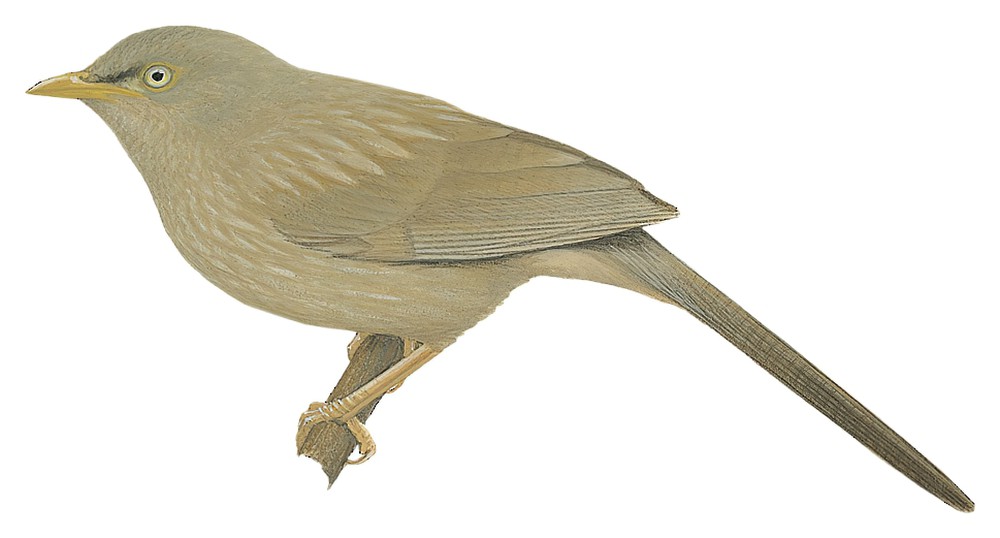Jungle Babbler / Turdoides striata

Jungle Babbler
SCI Name:
Protonym: Cossyphus striatus Dict.Sci.Nat. 29 p.268
Taxonomy: Passeriformes / Leiothrichidae / Turdoides
Taxonomy Code: junbab2
Type Locality: Bengal.
Author: Dumont
Publish Year: 1823
IUCN Status:
DEFINITIONS
TURDOIDES
(Leiothrichidae; Ϯ White-headed Babbler T. leucocephala) Genus Turdus Linnaeus, 1758, thrush; Gr. -οιδης -oidēs resembling; "Turdoides leucocephala, (Mus. Francof.) Weißköpfiger Droßling. ... Die Droßlinge (Turdoides) bilden eine von den Droßeln (Turdus) wohl zu unterscheidende Familie, die eine Menge von Arten zählt, von denen Rüppel bereits vier aus dem nördlichen Afrika eingesendet hat. Wir werden die Abbildungen und Beschreibungen von dreyen derselben in dem Atlas liefern. Auch erwarten wir duie Bekanntmachung anderer in Indien entdeckten Arten der Gattung Turdoides von Herrn Temminck, der solche zuerst aufgestellt hat." (Cretzschmar 1827); "Turdoides Cretzschmar, 1827, in Rüppell's Atlas, Vög., hft. 4, p. 6, pl. 4. Type, by monotypy, Turdoides leucocephalus Cretzschmar." (Deignan in Peters 1964, X, 331).
Var. Tordoides.
Synon. Aethocichla, Aipunemia, Crateropus, Cratopus, Ischyropodus, Layardia, Malacocircus, Malcolmia, Pengia.
turdoides
L. turdus thrush; Gr. -οιδης -oidēs resembling.
● “Both Seebohm and Saunders have used Meyer’s name Sylvia turdoides, 1815, for the Great Reed-Warbler, because, according to the first named, Linnaeus in placing the species under the genus Turdus made the definition quite misleading. Turdus arundinaceus of Linnaeus was, however, founded on Klein’s Turdus musicus palustris, which undoubtedly refers to the Great Reed-Warbler, and there can be no objection to the name, which is the oldest and has always been more or less in use” (BOU 1915) (syn. Acrocephalus arundinaceus).
● “Altogether of a much Thrush-like appearance” (Hartert 1896) (Cataponera).
● "14. COLLURICINCLE GRIVELÉ. — COLLURICINCLA TURDOIDES. ... Ce Colluricincle est originaire de Raffles-Bay. Il appartient à la section des espèces de ce genre qui est caractérisée par un bec plus large et moins comprimée. Ses couleurs et sa petite taille le rapprochent du Colluricincla brunnea Gould; il s'en isole par la coloration à peu près uniforme de la région thoraco-abdominale." (Pucheran 1853) (syn. Colluricincla parvula).
striata
L. striatus striated < striare to striate < stria furrow (see also striatus).
● ex “Blue-striped Roller” of Latham 1781 (Aplonis).
● “Tringa striata Linn., 1766, used in the former edition of the List, has been shown to refer to the Redshank and not to the Purple Sandpiper” (BOU 1915) (syn. Calidris maritima).
● ex “Choucas de la Nouvelle Guinée” of d’Aubenton 1765-1781, pl. 629, and “New-Guinea Crow” of Latham 1781 (Coracina).
● ex “Promérops de la nouvelle Guinée” of d’Aubenton 1765-1781, pl. 638, and “Promérops brun à ventre rayé” of de Buffon 1770-1783 (syn. Epimachus fastuosus).
● ex “Transverse Striped Dove” or “Barred Dove” of Edwards 1751, and “Turtur Sinensis striatus” and “Turtur Indicus striatus” of Brisson 1760 (Geopelia).
● ex “Rasle rayé des Philippines” of Brisson 1760 (Lewinia).
● ex “Gros-bec de l’Île de Bourbon” of Brisson 1760 (Lonchura).
● (Statius Müller 1776) ex “Pic rayé de St. Domingue” of d’Aubenton 1765-1781, pl. 281 (Melanerpes).
● (Boddaert 1783) ex “Picus dominicensis striatus” of Brisson 1760, and “Pic rayé de St. Domingue” of d’Aubenton 1765-1781, pl. 281 (syn. Melanerpes striatus).
● (J. Gmelin 1788) ex “Picus dominicensis striatus” of Brisson 1760, “Pic rayé de St. Domingue” of d’Aubenton 1765-1781, pl. 281, and “Rayed Woodpecker” of Latham 1782 (syn. Melanerpes striatus).
● ex “Onglet” of de Buffon 1770-1783, and “Furrow-clawed Tanager” of Latham 1783 (syn. Pipraeidea bonariensis).
● ex “Traquet à Queue Striée” of Levaillant 1806, pl. 188, fig. 1 (syn. Saxicoloides fulicatus).
● ex "Blackpoll Warbler" of Latham 1783 and Pennant 1785 (syn. Setophaga striata).
● ex “Striated Tern” of Latham 1785 (Sterna).
● ex “Totanus striatus” of Brisson 1760 (syn. Tringa totanus).
● ex “Striped-headed Finch” of Latham 1783, and “Striped Finch” of Pennant 1785 (syn. Zonotrichia albicollis).
SUBSPECIES
Jungle Babbler (Jungle)
SCI Name: Turdoides striata [striata Group]
TURDOIDES
(Leiothrichidae; Ϯ White-headed Babbler T. leucocephala) Genus Turdus Linnaeus, 1758, thrush; Gr. -οιδης -oidēs resembling; "Turdoides leucocephala, (Mus. Francof.) Weißköpfiger Droßling. ... Die Droßlinge (Turdoides) bilden eine von den Droßeln (Turdus) wohl zu unterscheidende Familie, die eine Menge von Arten zählt, von denen Rüppel bereits vier aus dem nördlichen Afrika eingesendet hat. Wir werden die Abbildungen und Beschreibungen von dreyen derselben in dem Atlas liefern. Auch erwarten wir duie Bekanntmachung anderer in Indien entdeckten Arten der Gattung Turdoides von Herrn Temminck, der solche zuerst aufgestellt hat." (Cretzschmar 1827); "Turdoides Cretzschmar, 1827, in Rüppell's Atlas, Vög., hft. 4, p. 6, pl. 4. Type, by monotypy, Turdoides leucocephalus Cretzschmar." (Deignan in Peters 1964, X, 331).
Var. Tordoides.
Synon. Aethocichla, Aipunemia, Crateropus, Cratopus, Ischyropodus, Layardia, Malacocircus, Malcolmia, Pengia.
Jungle Babbler (Black-winged)
SCI Name: Turdoides striata somervillei
somervillei
Dr William Somerville (1771-1860) British Army surgeon, civil commissioner, explorer in South Africa, Commander of the Army Medical Department, Scotland 1813-1816 (Turdoides).
UPPERCASE: current genus
Uppercase first letter: generic synonym
● and ● See: generic homonyms
lowercase: species and subspecies
●: early names, variants, mispellings
‡: extinct
†: type species
Gr.: ancient Greek
L.: Latin
<: derived from
syn: synonym of
/: separates historical and modern geographic names
ex: based on
TL: type locality
OD: original diagnosis (genus) or original description (species)












